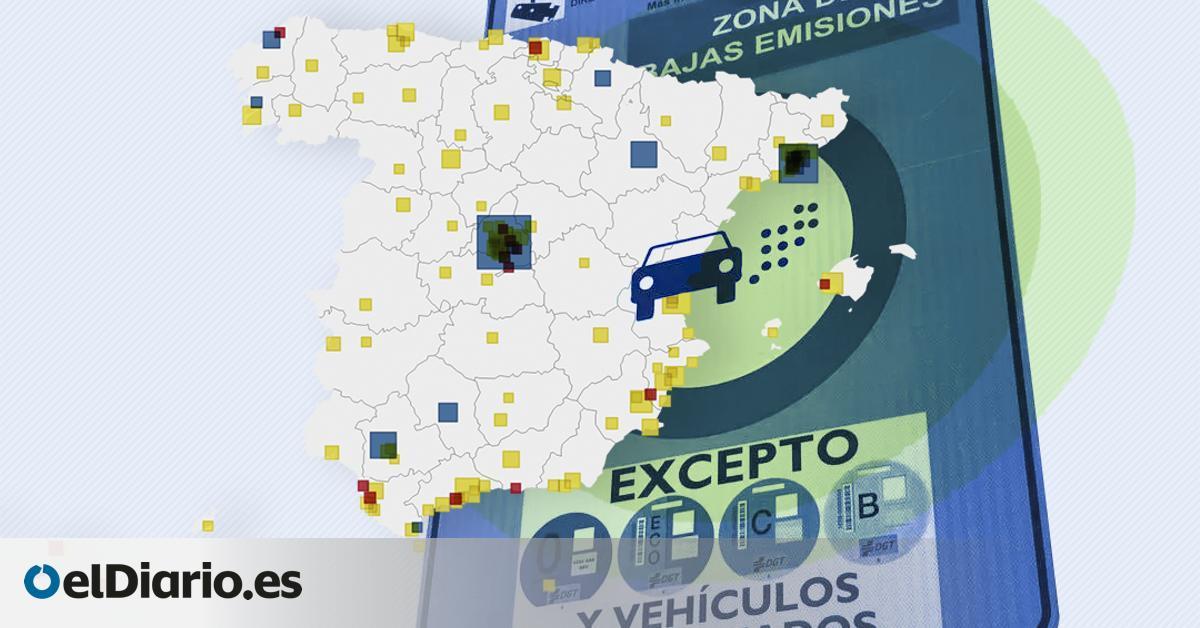
It took three months (with holidays in between) for the new mayor of Badalona, Xavier García Albiol (PP), to launch the Low Emissions Zone in the fourth most populated municipality in Catalonia. He intends to deactivate it by lifting its restrictions. It was one of the only 14 areas in operation – out of 149 – in towns with more than 50,000 inhabitants, where it has been mandatory since January 1, according to the registry of the Ministry of Ecological Transition. It’s just 9%.
Low Emission Zones (ZBE) are not an option. They have been a legal requirement since May 21, 2021, when the Climate Change Law came into force, which seeks, among other things, to “improve air quality.” Air pollution is directly related to the death of people in cities and to climate change, which is exceeding the scales of meteorologists this year. These municipalities (and the island territories) had more than a year and a half to implement them. The deadline was January 1, 2023.
This low-emission zone project, in addition to the legal obligation, has received financing from European recovery funds. The different projects presented by the cities total, for the moment, a disbursement of 1,500 million euros approved and delivered by the central government. As of September 2023, these 14 ZBEs are in force, plus another three from municipalities around Barcelona (in Catalonia, an agreement was reached to extend the implementation of areas with less traffic to populations of more than 20,000 residents).
“We are very late and there would have to be gigantic progress in this final quarter for them to be launched this year,” reflects the person in charge of Mobility at Greenpeace, Cristina Arjona. “First it slowed down because the royal decree on ZBE arrived in December 2022, in fact the Ministry is being flexible for that, but, after the municipal elections, changes in local governments have come and it has gone from delayed to, in some cases “Take steps back,” he concludes.
In the Ministry’s registry, the majority of remaining cities are classified as “in process,” although there are more than 15 “pending,” that is, “without procedures initiated,” as described by the Ecological Transition.
We are very late and there would have to be gigantic progress in this final quarter for them to be launched this year
Cristina Arjona
— Mobility Manager at Greenpeace
What García Albiol has done in Badalona is announce that he will approve a moratorium on traffic restrictions in the ZBE. “You cannot punish neighbors for changing their car in the middle of such a difficult economic time,” justified the PP politician. In reality, the regulations explain that this measure must seek to “promote modal change towards more sustainable means of transport, prioritizing active mobility and public transport.” And within that objective include “restrictions on access, circulation and parking of vehicles, according to their polluting potential.”
Carmen Duce, Transportation coordinator at Ecologistas en Acción, explains that “as neither the law nor the royal decree that develops the zones contemplates sanctions, this has allowed the process to be delayed.” “What we have been able to see on site The thing is that, at first, the town councils had no idea what a low-emissions zone means and since the Government decree did not arrive until December 2022, that allowed them to throw the ball out there,” explains Duce.
Where there was political will, they told us that doing it before March 28 was suicide. And then where there has been a change of City Council it seems that there was a slogan of “not this because it is what the others did.”
Carmen Duce
— Transportation Coordinator at Ecologistas en Acción
The thing is that before that, in November 2021, Ecological Transition published guidelines on how these areas could be implemented. A document to guide cities that were obliged to develop their ZBE. There, four routes were collected to take cars out of the cities. Even the royal decree that was drawn up a year later contemplates that those municipalities that had implemented restricted traffic zones before the royal decree would have 18 months to tweak their plans and adapt them to the regulations if they did not fit.
“Then came the municipal elections of March 28,” Duce continues. “Where there was political will, they told us that doing it before the vote was suicide. And then we have detected that where there has been change, it seems that there was a slogan of This is not because it is what others did.ignoring, of course, the legal commitment, the commitment to health, the fight against climate change and, in addition, some allocated funds.”
What seems bad, then no one wants to remove it
The acting vice president of Ecological Transition, Teresa Ribera, has warned based on García Albiol’s announcement that “the Government will supervise all projects and will have to return the amounts if they are not implemented in the manner and on time.” Badalona has received one million euros of European funds just for the implementation project of this low emissions zone.
Arjona understands that in the matter of low-emission zones there has been “a lack of disclosure and dissemination to the population about what they entail because, in the end, it seems that they are a nuisance instead of something positive.” Duce agrees: “It was explained very poorly. “It has been played with the idea that only electric cars could be used, that is, something for the rich, and in reality it is about a lot of other things such as active mobility, cycling or public transport.”
Furthermore, Carmen Duce points out another circumstance: “All the appeals before the courts that have been presented when there were measures in Madrid, Barcelona, Valladolid, Burgos, Gijón… have made the town councils choose to do so via municipal ordinance which, although they have Its positive side is because there is more public information, they make the process slower.”
The idea of having these areas with less traffic is to “reduce emissions.” [de gases] derived from mobility,” explains the law. More than a quarter of emissions in Spain are produced by automobiles, according to data from the Ministry of Ecological Transition. In Barcelona, for example, 60% of nitrogen dioxide comes from vehicles, according to the City Council. In Madrid, approximately a third of all greenhouse gases come from exhaust pipes. It is, by far, the main polluter, according to municipal tables.
“In reality, implementing them will improve health, climate change, urban space, it will give more space to pedestrians, it will make public transportation work better…” details Cristina Arjona. “It has been a handicap that this positive dissemination has not been carried out because, once these measures are implemented, the population sees what they are like and no one wants to reverse them,” comments this civil engineer who illustrates the argument with the case of the pedestrianization of Consell de Cent in Barcelona that a judge has ordered eliminated once it was executed, after a complaint from a group of merchants. Now, no one there wants to lose her. “I was a detractor, but I like it,” a neighbor commented to elDiario.es after learning of the court ruling.
The car is the least used
Both Arjona and Duce insist on the need for all planned areas to be completed. This Thursday, the Ministry of Ecological Transition and the Ministry of Transport, in the midst of events for Mobility Week, have jointly insisted on the importance of ZBEs since they “prioritize travel on foot or by bicycle and public, collective transport and decarbonized, compared to other more polluting modes of transport.”
“You cannot engage in political revenge,” concludes Duce. “The first thing should be the health and well-being of the population. The steps backwards are sometimes ridiculous and it must also be said that the majority of daily trips are on foot or by public transport and cars are a minority.
In this sense, official data from the Community of Madrid say that private cars represent 39% of daily trips. In the city of Barcelona, the car accounts for only 25% of all trips. In the metropolitan area of Valencia and Seville it is 40%.
“But – concludes the environmentalist – cars take up a lot of space on the streets and it seems that they also take up a lot of space in the minds.”
Source: www.eldiario.es

